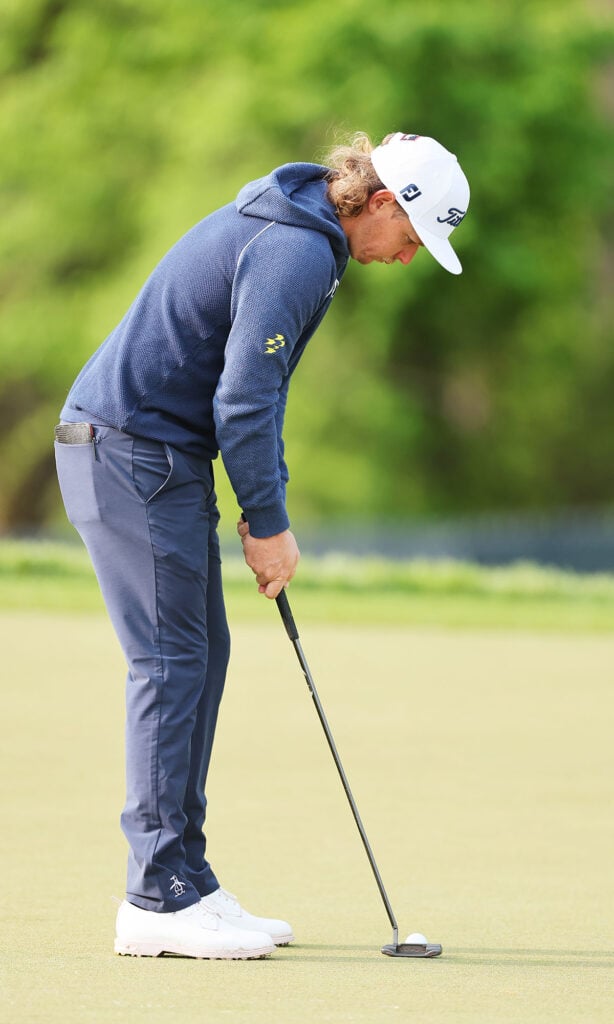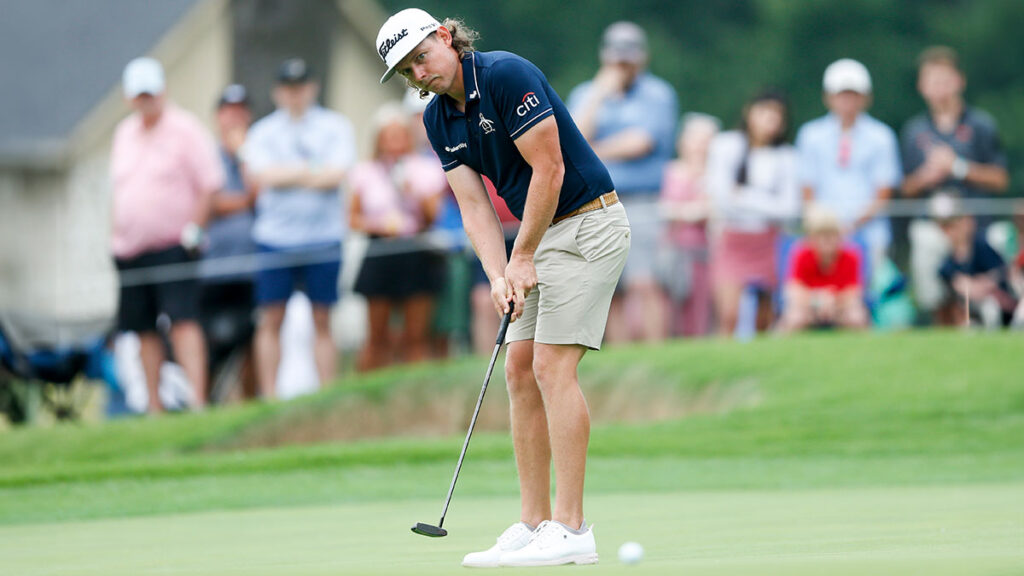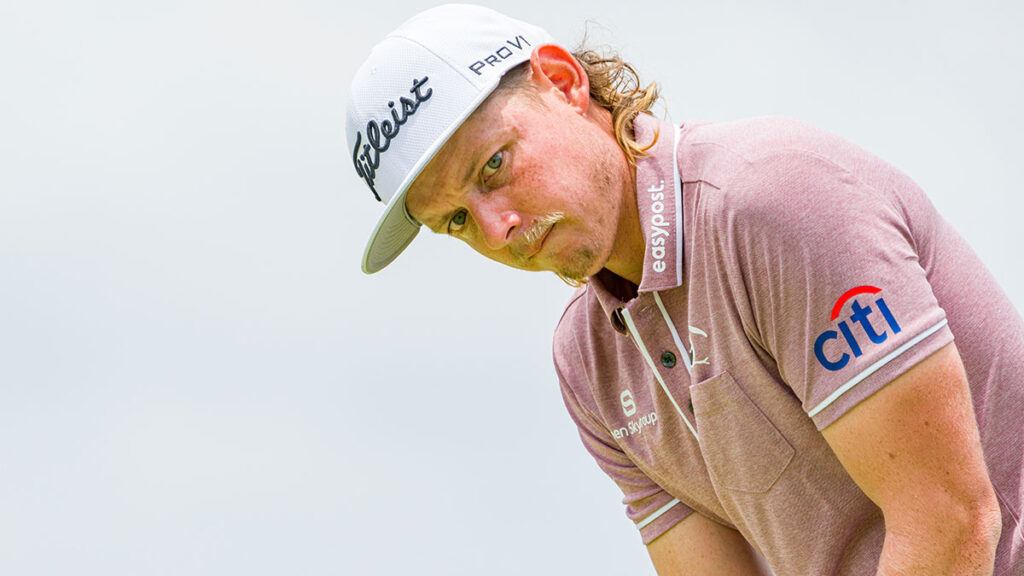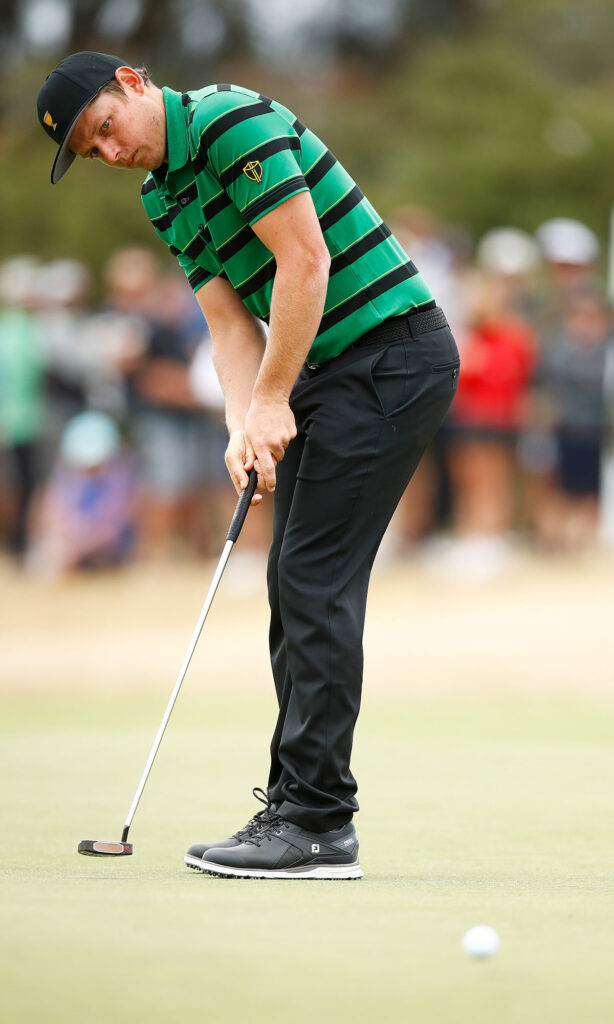The magic move in Cam Smith’s putting routine, explained.
Image by getty images: GIORGIO VIERA; istock.com/FOTOKITA
I’ve always thought that making a putt feels like a magic trick. It’s surprising, and something that sometimes feels impossible. Good putters? Those are the true wizards. The ones who have somehow mastered this strange form of magic. Cameron Smith is the ultimate magician. His putter is his magic wand and he conjures up incredible things on the greens.
But like every good magic trick, look closely enough and you’ll be able to spot the secret. A subtle mix of mental and technical movements which, when put together, reveal the facts and the fiction about the fickle art of putting.

A daily routine
The first, and perhaps most important, thing to know about Smith’s approach to putting is that he’s not spending hours stressing on the practice putting green. He works hard, of course, but for Smith it’s really more of a quality over quantity thing. What that means is that every day Smith uses a mirror to make sure he sets up to his putter the same way, every time.
“I definitely keep on top of it… For me it’s just about getting back to the same setup position. I practise with a mirror for probably 20 minutes a day and, to be honest, that’s about it. I don’t really hit a lot of long putts at home. I try to focus on putting from 10 to 15 feet and in and just seeing those putts drop.”
The whole practising with a mirror thing may seem a little tedious, but for Smith, it’s genuinely important. One of the reasons why is because Smith is left-eye dominant, like Jack Nicklaus and Tiger Woods and some others. It’s one of the reasons why using a mirror is so important for him. Golfers who are right-eye dominant tend to aim their eyes and shoulders out to the right. Smith is left-eye dominant, which means his bad habit is aiming too far to the left, he says. It can cause him to miss putts left.
The mirror helps him counteract this. When Smith checks his setup using one, he’s looking to make sure his feet and shoulders are exactly square to his target line, and that his dominant left eye is directly over the golf ball.
The margins are so thin in putting, and it makes the details really important. A tiny mistake or misalignment somewhere could mean a missed putt. For Smith, it’s these daily mirror checks that prevent those bad habits from baking in.

Short follow through
In Smith’s stroke itself, you’ll notice that his follow-through is significantly shorter than his backstroke.
There’s an interesting reason for this. Lots of amateur golfers work hard on trying to accelerate the putterhead aggressively through the ball, so their follow through is longer than their backstroke. But that’s kind of a bad idea. It’s part of this irrational fear golfers have of not decelerating through
the ball.
World renowned putting coach Phil Kenyon calls this one of the “biggest putting myths” in golf and it can cause all kinds of problems with distance control, because you’re trying to apply a very specific, small amount of force. It doesn’t take much to accidentally hit a putt too hard, and worst case, it creates a yippy stroke.
Instead, Smith and his coach, Grant Field, work on keeping the putterhead moving at a constant speed. Back the same and through at the same pace and speed. The golf ball simply gets in the way of the stroke. And just like Newton’s cradle, once the putterhead impacts with the ball, it slows down and transfers its energy into the golf ball, which causes it to speed up.
There’s lots of good science that shows how and why this happens, if you want to go deeper, and it’s also something many of the great putters figured out intuitively, like the great Ben Crenshaw.
“Remember, you want to use the same tempo every time,” Crenshaw preaches. “The only variable is the length of your backswing. Some pros advocate using a short backswing that makes you accelerate through the ball. I think this is bad advice. I don’t believe in the jab stroke. I think you’ve got to be smooth.”

No practice strokes
Finally, and quite interestingly, Smith doesn’t take practice strokes before he hits his putts. Instead, he takes one long, deliberate look at the hole. It’s something you can even spot him doing in his full swing.
I asked him about it once and he said, “It doesn’t matter whether it’s two feet or 100 feet, taking that last look, you want to see the ball roll over the front with the pace that you like.” He’s zoning into his target, like a cricketer waiting to spot the right ball to slash to the boundary. Smith says, “it’s something that I’ve always done, and I think it’s key”.
For Smith, it’s a moment of zen. Allowing him to feel the shot in his body, and in his mind. For the rest of us in the audience, though, it’s setting the stage. A brief moment to catch our breaths, as we anticipate the magic soon to come.

Cam’s favourite magic wand
“The Scotty Cameron TFB 1.5 Teryllium putter is probably my favourite putter ever,” Smith says. “I just love the way it swings, sits and how the ball comes off the face. That’s three pretty big boxes to tick. I felt like I could still make a bit of an error through the stroke, and the ball would come off the face close to that of a good stroke. It had a bit of a long haul in the bag. I’ve always been one to shuffle putters in and out, but that one found a sweet spot. I first put it in play at the 2019 Presidents Cup.”



